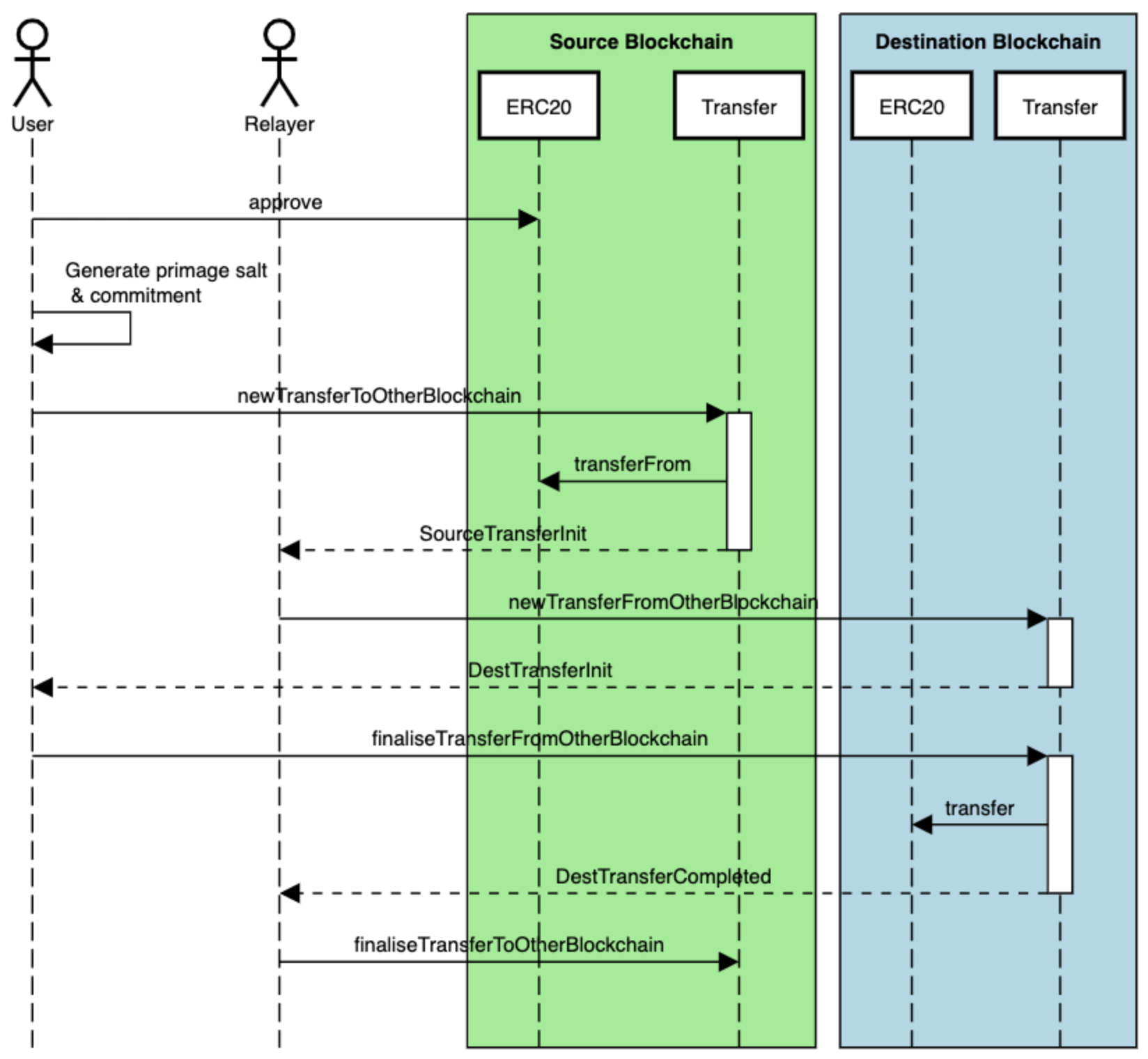This repo is no longer in use. It contains historical information about the HTLC token bridge. Please see https://github.com/ConsenSys/gpact for information about the General Purpose Atomic Crosschain Transaction protocol.
The repo contains code for a bi-directional Hash Time-Locked Contracts (HTLC) based token bridge. As shown in the simplified architecture diagram below, ERC20HtlcTransfer contracts are deployed on two blockchains. They allow ERC 20 tokens from one blockchain to be moved to another blockchain, and then later moved back to the original blockchain.
Need to write a section introducing users and relayers.
The diagram below walks through a standard sequence of steps required for a user to transfer some tokens from an ERC20 contract on one blockchain to another blockchain.
Walking through the diagram:
- A user submits a transaction to the ERC 20 contract on the source blockchain to
approve up to a certain number of tokens to be transferred by the
ERC20HtlcTransfercontract by calling the ERC 20 contract'sapprovefunction. - The user generates a random pre-image-salt, and calculates a commitment based on the pre-image-salt, the user's address, the address of the ERC 20 contract on the source blockchain, and the number of tokens to be transferred.
- The user submits a transaction to the
ERC20HtlcTransfer,newTransferToOtherBlockchain, specifying the token address, the number of tokens to transfer, and the commitment value. - During the
newTransferToOtherBlockchaincall, theERC20HtlcTransfercontract calls the ERC 20 contract'stransferFromfunction to transfer tokens from the user to theERC20HtlcTransfercontract. Additionally, aSourceTransferInitevent is emitted. - Relayers monitor the source blockchain, looking for
SourceTransferInitevents. - When a relayer sees a
SourceTransferInitevent, it submits a transaction to theERC20HtlcTransfercontract on the destination blockchain, calling thenewTransferFromOtherBlockchainfunction, submitting the user's account address, the ERC 20 token's address on the source blockchain, and the amount to transfer. ADestTransferInitevent is emitted as part of the execution of thenewTransferFromOtherBlockchainfunction. - The user monitors the destination blockchain, waiting for the
DestTransferInitevent to be emitted. - When the user sees the
DestTransferInitevent for their transfer, they call thefinaliseTransferFromOtherBlockchainfunction on theERC20HtlcTransfercontract on the destination blockchain, passing in the commitment and the pre-image-salt, to finalise the transfer from their perspective. - When the
finaliseTransferFromOtherBlockchainfunction is called, the code looks up the mapping between the source blockchain's ERC contract address to destination blockchain's ERC 20 contract address, and then calls thetransferfunction on the ERC20 contract on the destination blockchain to transfer the tokens from theERC20HtlcTransfercontract to the user. TheDestTransferCompletedevent is emitted. - Relayers monitor the destination blockchain, looking for
DestTransferCompletedevents. - When a relayer sees a
DestTransferCompletedevent, it submits a transaction to call thefinaliseTransferToOtherBlockchainon theERC20HtlcTransfercontract on the source blockchain, submitting the commitment and the pre-image-salt. Doing this finalises the transfer from the relayer's perspective.
The ERC20HtlcTransfer contracts have source and destination
time-lock periods. These time-locks help ensure the funds are transferred
securely. The source time-lock starts when the user calls the
newTransferToOtherBlockchain function on the ERC20HtlcTransfer
contract on the source blockchain. The destination time-lock starts when
a Relayer submits the newTransferFromOtherBlockchain function on the
ERC20HtlcTransfer contract on the destination blockchain.
The transfer times-out on the destination blockchain if the
User has not called the finaliseTransferFromOtherBlockchain function
on the ERC20HtlcTransfer contract on the destination blockchain prior
to the destination time-lock period. Calling this function makes the
pre-image-salt value to the Relayers.
In some circumstances, the User may need to execute a refund. If the
transfer were to fail, for instance if no Relayer called
newTransferFromOtherBlockchain function on the
ERC20HtlcTransfer contract on the destination blockchain, or
if the User did not call the
finaliseTransferFromOtherBlockchain function
on the ERC20HtlcTransfer contract on the destination blockchain,
then the User's tokens on the source blockchain would be owned by
the ERC20HtlcTransfer and they wouldn't have any tokens on the
destination blockchain. In this case, the User is able to request a
refund by calling the refundTransferToOtherBlockchain function
on the ERC20HtlcTransfer contract on the source blockchain. This
function must be called after the source time-lock period has expired.
It should be noted that if the Relayers fail to call
finaliseTransferToOtherBlockchain on the ERC20HtlcTransfer contract
on the source blockchain prior the source time-lock period expiring
after the User has called the finaliseTransferFromOtherBlockchain function
on the ERC20HtlcTransfer contract on the destination blockchain, then
the User will have the tokens on the destination blockchain and be able to
request a refund on the source blockchain. to prevent this from occurring
the destination time-lock period should be a significantly
shorter period of time than the source time-lock period to protect the relayer
from malicious users.
- More unit tests and integration tests.
- More documentation.
- Improve performance of relayer.
- Support for ERC 721 NFT tokens are coming!

